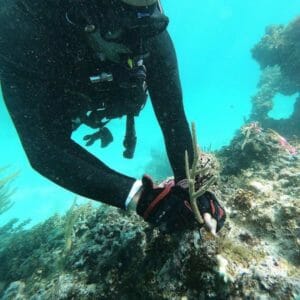
A new study published in Restoration Ecology by researchers from Arizona State University’s Center for Global Discovery and Conservation Science found evidence that particulate organic carbon levels are one of the most important factors in determining coral outplant survival. Author Greg Asner is a sustainability scientist and center director.
This new finding suggests that potential coral outplanting sites should be selected in areas where sedimentation levels are low, away from coastal development, or where coastal development is carefully managed for reef conservation.
“New restoration protocols can use remotely sensed data of multiple oceanographic variables to assess the environmental history of a site. This will help evaluate and optimize site selection and give their outplants the best chance of survival,” said Shawna Foo, lead author and postdoctoral researcher at the ASU center.
The abstract follows.
Globally, coral reefs are degrading due to a variety of stressors including climate change and pollution. Active reef restoration is an important effort for sustaining reefs where, typically, coral fragments are outplanted onto degraded reefs. Coral outplants; however, can experience mortality in response to a range of stressors. We pair results of outplant monitoring observations with satellite‐based measurements of multiple oceanographic variables to estimate the relative importance of each driver to coral outplant survival. We find that when considering mean environmental conditions experienced by outplants during the monitoring period, particulate organic carbon (POC) levels are most important in determining outplant survival, with certain levels of POC beneficial for outplants. Sea surface temperature anomalies (SSTA) are also important determinants of outplant survival, where survival is greatest in regions with minimal or slightly negative anomalies. Survival also increases with increasing distance to land, likely due to a reduction in negative ridge‐to‐reef effects on coral outplants. When considering the range (min – max) of environmental conditions experienced during the monitoring period, large fluctuations in photosynthetically active radiation (PAR) and POC are most important in determining outplant survival. Increasing outplant depth can help to counter the negative impacts of large fluctuations in environmental variables. We find that a variety of remotely sensed oceanographic variables have significant impacts on survival and should be considered in coral restoration planning to help evaluate potential restoration sites and ultimately maximise coral outplant survival.